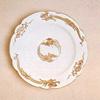- Chantilly porcelain
-
Either of two types of soft-paste porcelain produced from с 1725 to с 1800 at Chantilly, France.In the first type, made until с 1750, an opaque, milk-white tin glaze was applied to a yellowish ground; the designs were simplified Japanese patterns. In the second type (с 1750–1800), a traditional transparent lead glaze was applied over a coloured ground; the designs were influenced by Meissen and Sèvres porcelain. Production consisted primarily of domestic ware (plates, basins, jugs) with painted decoration in a limited palette. The motifs were often small flower bouquets, known as Chantilly sprigs, or scrolls and plaits.
 Chantilly porcelain plate decorated with dragons, c. 1725; in the Victoria and Albert ...By courtesy of the Victoria and Albert Museum, London
Chantilly porcelain plate decorated with dragons, c. 1725; in the Victoria and Albert ...By courtesy of the Victoria and Albert Museum, London* * *
▪ French potterycelebrated soft-paste porcelain produced from 1725 to c. 1789 by a factory established in the Prince de Condé's château at Chantilly, Fr. Two periods can be distinguished, according to the composition of the porcelain; in the first, up to about 1740, a unique, opaque milk-white tin glaze was applied on a rather yellowish body; in the second (1741–89), a traditional, transparent lead glaze was used.The preoccupation of Chantilly, until the Prince died in 1740, was with Japanese Kakiemon designs. Some of his designs were directly inspired by his large collection of the ware, others derived from Meissen versions of these Oriental motifs, such as the “Red Dragon” service, which, in iron-red and gilding, became the Chantilly Prince Henri pattern. Other Japanese patterns simplified and adopted included the quail, partridge, flying squirrel, and pomegranate.Porcelain produced in the second period was influenced first by Meissen and then by Sèvres, both in modelling and in the use of coloured grounds. Some rare figures reflecting Chinese influence were modelled, as well as bird figures and small statuette flower holders. The main production, however, consisted of domestic ware—plates, jugs, basins, and jardinieres—enhanced by an effective economy of decoration painted in underglaze blue only or at best with a limited palette, which was the result of Royal edicts in favour of the Sèvres. The motif was often small flower bouquets known as Chantilly sprigs or more formal scrolls and plait work.* * *
Universalium. 2010.
